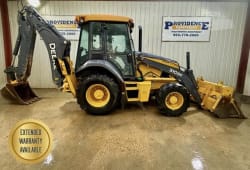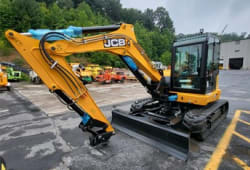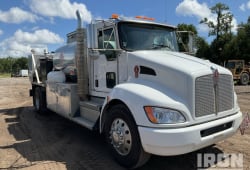How to Evaluate the Performance of Used CAT Heavy Equipment?
9 Min read
)
January 6, 2024
When it comes to acquiring used Caterpillar heavy equipment, savvy buyers understand the importance of a thorough evaluation. Investing in pre-owned machinery can offer significant cost savings, but ensuring that the equipment meets performance standards is crucial. This comprehensive guide will walk you through the key steps and considerations to effectively evaluate the performance of used Caterpillar heavy equipment. From inspecting crucial components to assessing maintenance records, we'll cover everything you need to know to make informed decisions and secure reliable machinery that aligns with your operational requirements. Whether you're expanding your fleet or replacing aging equipment, this guide is your essential companion in the used heavy equipment acquisition journey.
Understanding Your Equipment Needs
Before diving into the evaluation process, it's essential to clearly define your specific equipment needs. Understanding your equipment requirements is paramount-consider factors such as the type of project, workload, and environmental conditions. This initial step will guide your evaluation process and help you focus on the features that matter most to your operations. Accurate assessment ensures optimal performance and efficiency in meeting your project objectives. Choose wisely for lasting success.
Researching Caterpillar Models and Specifications
Knowledge is power, especially when it comes to evaluating used heavy equipment. Begin by researching different Caterpillar models and their specifications. Familiarize yourself with the performance benchmarks and capabilities of the equipment you are interested in. Understanding the model's original specifications will serve as a baseline for your evaluation. Researching Caterpillar Models and Specifications ensures informed decision-making, providing valuable insights into the equipment's history and potential performance.
Inspecting the Exterior
Visual Inspection
Begin your assessment with a thorough visual inspection of the exterior. Examine the body, frame, and components for indications of wear, rust, or damage. Scrutinize welds, seals, and joints closely. Document any visible issues that could impact the equipment's performance or safety. This meticulous visual inspection is crucial for identifying potential problems early on and ensuring the equipment's overall integrity.
Fluid Checks
Performing regular maintenance on heavy machinery is crucial for optimal performance. Inspect all fluid levels, including engine oil, hydraulic fluid, and coolant during routine checks. Discolored or contaminated fluids may indicate potential problems. Additionally, perform "Fluid Checks" for any visible leaks around hoses, connectors, and hydraulic components. Adequate fluid levels and quality are essential indicators of a well-maintained machine, ensuring longevity and efficient operation.
Assessing the Mechanical Condition
Engine Performance
Evaluate the engine's performance by conducting a thorough start-up and idling inspection. Listen for unusual sounds, vibrations, or smoke emissions. Rev the engine and observe its responsiveness. If possible, request maintenance records to assess the regularity and quality of past servicing. Engine Performance is crucial; ensure it meets standards for optimal functioning, addressing any issues found during the evaluation to guarantee reliable and efficient operation.
Transmission and Drivetrain
When assessing a vehicle's overall performance, it is crucial to meticulously inspect its various components. Examine the transmission and drivetrain for smooth operation through all gears, testing both forward and reverse functionality. Identify potential issues with shifting or unusual noises. Scrutinize drive train components, including axles, differentials, and drive shafts, for signs of wear or damage. Thorough evaluation ensures optimal functionality and longevity.
Hydraulic System Evaluation
The hydraulic system is critical for heavy equipment functionality. Test all hydraulic functions, including lifting, lowering, and tilting mechanisms. Inspect hydraulic hoses and connectors for leaks, wear, or damage. Evaluate the response time and overall performance of the hydraulic system under various conditions. Conduct a thorough Hydraulic System Evaluation to ensure optimal operation and identify any potential issues that may affect the equipment's efficiency and safety.
Testing Equipment Controls and Features
Control Panel Assessment
During the Control Panel Assessment, meticulously test all control panel functions to guarantee proper operation of switches, levers, and gauges. Confirm the effectiveness of safety features like emergency stops and warning indicators. Assess the controls for user-friendliness and responsiveness, recognizing their crucial role in enhancing operator efficiency and ensuring a safer operational environment.
Monitoring Technological Features
Modern Caterpillar heavy equipment often comes equipped with advanced technological features. Evaluate the functionality of telematics systems, GPS, and monitoring tools, focusing on "Monitoring Technological Features." Ensure that these features, if present, provide accurate data and contribute to overall equipment efficiency and maintenance. Regularly assess the integration and performance of these cutting-edge tools to maximize the benefits they bring to your heavy equipment operations.
Undercarriage Inspection
Track or Tire Examination
Inspect the undercarriage components, whether tracks or tires, depending on the type of equipment. Conduct a thorough Track or Tire Examination, checking for signs of wear, damage, or uneven tread patterns. Measure the track tension or tire pressure and ensure it aligns with Caterpillar's recommended specifications. A well-maintained undercarriage is crucial for equipment stability and longevity.
Frame and Suspension Evaluation
During the equipment inspection, meticulously scrutinize the frame and suspension components for stress, cracks, or misalignments. Frame and Suspension Evaluation is crucial; any issues here can compromise structural integrity. Utilize a level to detect unevenness, ensuring the equipment sits flawlessly on a flat surface. Vigilance in these aspects guarantees optimal performance and safety.
Verifying Maintenance and Service History
Reviewing Maintenance Records
When considering the purchase of used Caterpillar equipment, it is crucial to conduct a thorough evaluation. Request and thoroughly review the maintenance and service history of the equipment. A comprehensive record should include regular maintenance, repairs, and any major overhauls. Reviewing maintenance records provides insight into the level of care the equipment has received and potential future maintenance needs.
Identifying Previous Repairs
Inspecting heavy machinery is crucial for optimal performance. Look for signs of previous repairs or replacements. While some repairs are routine, frequent or extensive repairs may indicate underlying issues. Pay attention to the quality of replacement parts and ensure they meet Caterpillar's specifications. Identifying previous repairs helps assess the machine's history and potential reliability, aiding in informed decision-making.
Utilizing Diagnostic Tools
Engine Diagnostics
Utilize diagnostic tools like Caterpillar Electronic Technician (Cat ET) for comprehensive Engine Diagnostics. These tools offer crucial insights into the engine's health, encompassing data on performance, fuel efficiency, and potential issues. The electronic diagnosis significantly improves the precision of your assessment, ensuring a thorough understanding of your engine's condition.
Hydraulic System Diagnostics
Conducting Hydraulic System Diagnostics is crucial for optimal performance. Employing specialized tools, engineers assess pressure, flow rates, and system response, akin to engine diagnostics. This proactive approach enables early issue detection, ensuring timely maintenance and preventing critical malfunctions that could impede hydraulic system functionality.
Considering Safety Features
Rollover Protection Structures (ROPS) and Falling Object Protection Structures (FOPS)
Ensure the thorough assessment of Rollover Protection Structures (ROPS) and Falling Object Protection Structures (FOPS) to safeguard operators during rollovers or falling objects. Examine their condition and functionality meticulously, confirming compliance with Caterpillar's standards. Verify that these critical safety components remain uncompromised, free from damage or unauthorized modifications.
Lighting and Visibility
Ensure the equipment's optimal functionality by inspecting key components. Examine the engine, hydraulics, and brakes thoroughly to identify any potential issues. Lighting and visibility are paramount-check headlights, taillights, and work lights for proper operation. Mirrors and visibility aids should be in top condition to enhance overall safety, particularly in low-light conditions.
Assessing Wear Parts and Consumables
Wear Parts Inspection
Conducting comprehensive equipment assessments involves meticulous Wear Parts Inspection. Scrutinize crucial components like cutting edges, teeth, and bucket elements, assessing their wear levels. Swift identification of wear issues ensures timely replacements, offering valuable insights into equipment usage and reflecting the owner's dedication to proactive maintenance practices.
Consumable Component Evaluation
When conducting equipment inspections, it is vital to perform Consumable Component Evaluation. Check the condition of consumable components such as filters, belts, and lubricants. These elements are integral to the equipment's performance and longevity. It is imperative to confirm that consumables have been consistently replaced in adherence to Caterpillar's recommended maintenance schedule.
Testing Operational Performance
Load Testing
In assessing industrial machinery, it's crucial to ensure optimal performance. If feasible, conduct load testing to evaluate the equipment's functionality under actual working conditions. This test uncovers issues with power delivery, stability, and hydraulic functions when the equipment operates at its intended workload, ensuring seamless and reliable performance.
Fuel Efficiency Assessment
Conducting a Fuel Efficiency Assessment is crucial for optimal performance. Monitor fuel consumption to evaluate equipment efficiency. Deviations from Caterpillar's specified rates may signal engine or system issues. Understanding fuel efficiency is paramount for effective long-term cost management, ensuring sustainable operations and minimizing environmental impact.
Negotiating Price and Warranty Terms
Market Research
Before entering negotiations, conduct thorough market research to understand the fair market value of the specific Caterpillar equipment you are evaluating. Consider factors such as model year, usage, and overall condition. This knowledge will empower you during price negotiations. Accurate market research ensures informed decision-making and enhances your bargaining position.
Negotiating Warranty Terms
When purchasing equipment, it's crucial to secure a warranty for added protection. Negotiate warranty terms with the seller to ensure confidence in the equipment's condition. Clarify coverage duration and the types of issues included in the warranty, enhancing your overall purchase experience and peace of mind.
Conclusion
When considering the purchase of used Caterpillar heavy equipment, it's essential to conduct a comprehensive assessment. Begin by scrutinizing the machine's maintenance records, inspecting crucial components, and assessing its overall condition. Evaluate factors such as engine performance, hydraulic systems, and structural integrity. Additionally, consider seeking the expertise of qualified professionals or certified inspectors. Through a systematic approach to evaluation, you can confidently make informed decisions, aligning the equipment with your operational requirements and ensuring a prudent investment. In conclusion, evaluating the performance of used Caterpillar heavy equipment requires a systematic and thorough approach. By following these outlined steps, you can make informed decisions, ensuring that the equipment meets your operational needs and represents a sound investment. Remember that a comprehensive evaluation not only safeguards your financial interests but also contributes to the overall safety and efficiency of your construction or industrial operations.

Caleb Woods is an experienced content specialist and an editor at Boom & Bucket, blending his journalism background with expertise in the heavy equipment industry. He delivers engaging, informative content to help professionals stay informed and make smarter decisions in the machinery market.













